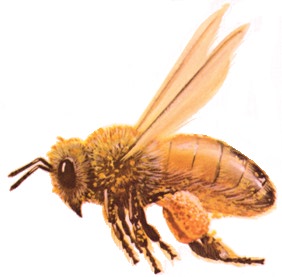

Children are most likely to encounter honey bees that are feeding at flowers or foraging. Bees may fly long distances (up to six miles) in search of food and may be quite far from home when they are seen in your yard or neighborhood.
Worker bees gather both pollen and nectar from flowers to feed to the larvae and other members of the colony. Nectar is the sweet fluid produced by flowers to attract bees and other insects, birds and mammals. Worker bees drink the nectar and store it in a pouch-like structure called the crop. They fly back to the hive and regurgitate the nectar to other "house bees." The house bees mix the nectar with enzymes and deposit it into a cell where it remains exposed to air for a time to allow some of the water to evaporate. The bees help the process along by fanning the open cells with their wings. The cell containing the resulting honey is later capped with beeswax and kept for future use.
Honey bees have lots of little hairs on their body. Even their eyes have hairs. Pollen sticks to the hairs while the bees are visiting the flowers. A furry little bee wiggling around inside the flower picks up a lot of pollen. After getting pollen on their body hairs, the bees move it to a special area on their hind legs called pollen baskets . Foraging bees returning to the hive often have bright yellow or greenish balls of pollen hanging from these pollen baskets.
Pollen is the yellowish or greenish powder-like substance that sometimes comes from flowers. It may be quite sticky. It contains the male contribution to the next generation of plants. Honey bees mix the pollen with some nectar to form a mixture called beebread that is a protein-rich food used to feed the larvae. As the worker bees move from flower to flower, they spread pollen to many different plants, including important foods such as vegetables (squash and cucum bers), fruits (apples, watermelon, plums, sweet cherries, citrus), nuts (almonds), plants grown for seed (sunflower), and animal feed crops such as clover.
There is evidence that Africanized honey bees spend more time collecting pollen than do European honey bees, because they need extra protein to produce more brood. One possible reason for the success of Africanized honey bees in displacing milder-tempered bees is that in every respect, the Africanized honey bees appear to be more efficient and more diligent. They get up earlier, work later, and visit more flowers per foraging flight than do European bees. When the moon is bright, Africanized honey bees will often continue to forage late into the night. This is part of the Africanized honey bee's tendency to favor expansion and frequent division of the colony, as opposed to the European honey bee's tendency to build up large, stable colonies full of honey in order to survive the winter.
Honey bees rely on their sense of vision to locate flowers. Bees see colors in the spectrum ranging from ultraviolet to orange, but do not see red, (Red flowers are visited by birds such as hummingbirds.) The flower advertises itself to the bees with colorful petals, many of which have shiny patches of ultraviolet that humans can't see except with special equipment. These ultraviolet patches are called bee guides or nectar guides. Like airport runway lights, these ultraviolet regions guide the bees to the nectar.
Shape of the flower is also important. Some flowers have flat areas for ease of landing by bees and others have elaborate modifications to ensure pollen sticks to any bee that visits.
During those hard times when there are few foraging opportunities, bees sometimes raid other, weaker colonies looking for honey to steal. The robber bees cannot enter a different hive unnoticed. Guard bees at the hive entrance usually try to fight off invaders in stinging duels. Africanized honey bees have a noticeable tendency to raid other colonies, especially during periods of drought or famine.
Honey bees are attracted to sweets, especially liquid sweets in the form of open cans of soft drinks. This is why they sometimes gather around eating areas at open air events, like fairs and carnivals, and crawl around on straws and can or bottle tops. While bees are generally not very aggressive while foraging for food or water, they can sting when disturbed, which makes them quite unwelcome at such events.
In addition to food, honey bees gather water for use in cooling the inside of the nest on hot days. They also use water to dilute the honey when they feed it to the larvae. Occasionally, honey bees collect the sticky resin and gum of trees and work into a substance called propolis. They used the propolis to plug unwanted openings in the hive so that mice and pests such as wax moths or ants can't get inside. The bees also spread a thin coating of propolis on the interior of the hive to protect against disease. When working a hive, the beekeeper uses a hive tool to pull apart the frames that may be stuck together with propolis.